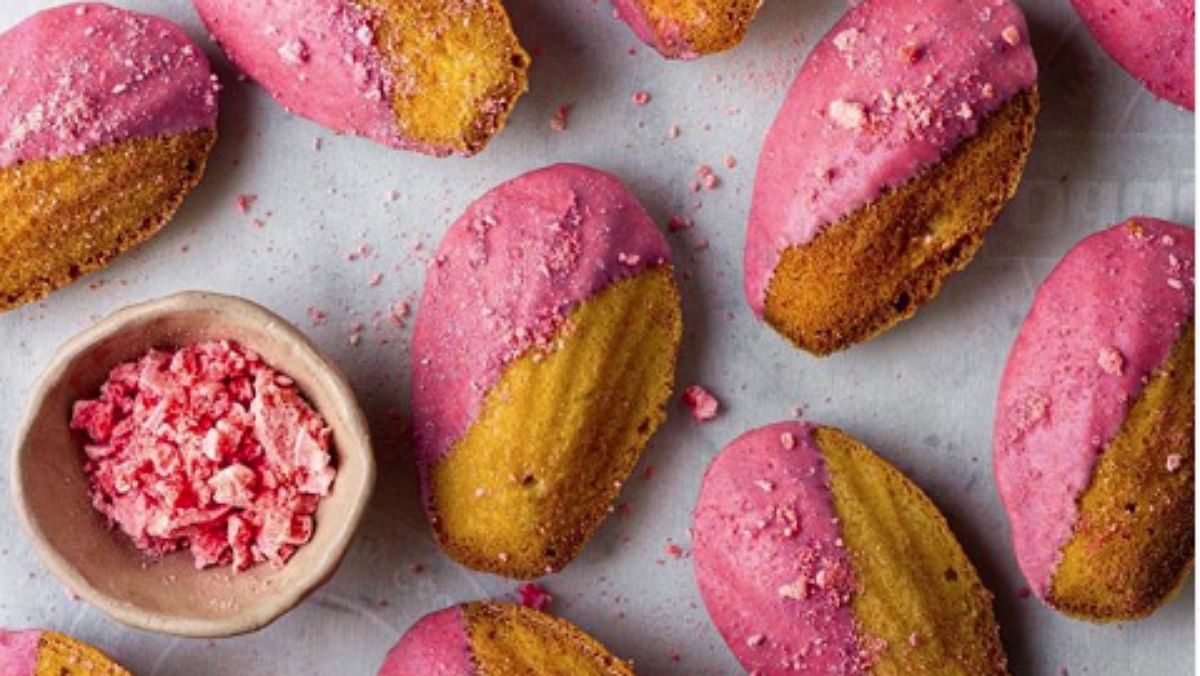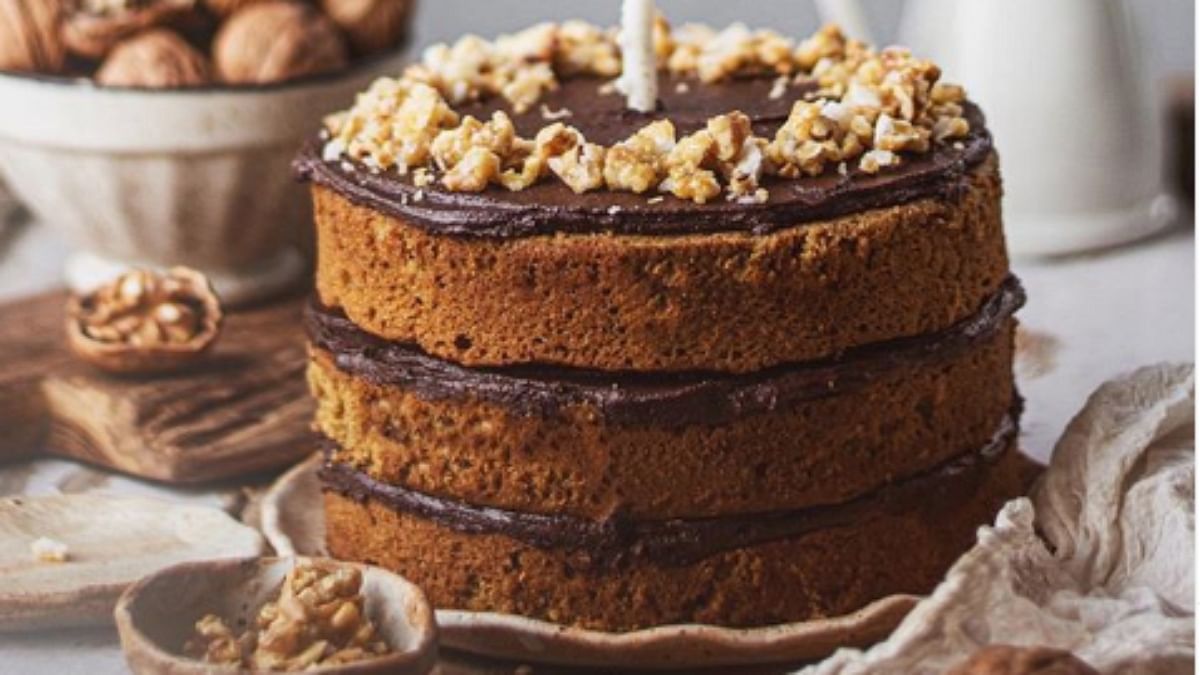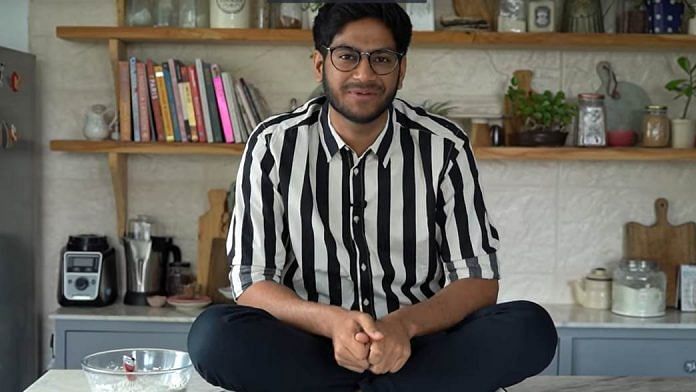New Delhi: Shivesh Bhatia is not your average professional baker. Instead of patisserie training and a puffy chef’s hat, he entered the world of desserts armed with, of all things, a degree in political science.
The Delhi boy, who studied at the capital’s Sardar Patel Vidyalaya and Hindu College, Delhi University, grew up in a joint family, in which his maternal grandmother wore the baker’s hat, metaphorically speaking.
When he was 16, his grandmother fell ill, and that was what led him to the kitchen. Today, the 23-year-old is a professional baker, a legit social media sensation (thanks to his easy recipes and beautifully styled and shot desserts) and the author of a cookbook, Bake With Shivesh (HarperCollins), which is also the name of his website and YouTube channel, and a second book on the way.
At the fifth edition of the Kerala Literature Festival on Kozhikode Beach, the self-taught baker and food blogger tells ThePrint all about how he began baking, his views on Instagram and the influencer bubble and how he is trying to combat the climate emergency in his own small way.
From political science to pots and pans
Being 16 is hard for most people and it was no different for Bhatia. Apart from adjusting to a new school, staying on top of things academically and trying to fit in and make friends, he was dealing with the fact that his grandmother, a mainstay of his joint family, fell ill and was in and out of the hospital for about 10 months.
But it was also the year that changed his life. “My nani used to bake quite often, nothing very elaborate, but the yummiest, simplest chocolate and vanilla cakes, and that was my introduction to baking,” says Bhatia.

“One day, during the time she was ill, my cousins and I were sitting together and talking about how much we missed her cakes, so we decided to get our hands on some premixes and ready-made frosting and make cupcakes. The first batch was an absolute disaster — we ended up burning the entire thing! But I just enjoyed being in the kitchen so much and I was super-fascinated (still am) with how all the ingredients just magically transform into something else in the baking process,” he says.
Always academically-inclined, Bhatia planned to become a lawyer. But it was during his undergrad days at the Hindu College that he decided to change tracks. It wasn’t that he didn’t enjoy what he studied — on the contrary, Bhatia recalls loving the academic rigour of the course.
“Classes would end by about 1 pm, and the first few months, we chilled at college, explored North Campus. But after a point I got sick of not doing much post-class and that’s when I decided to invest more time in baking — I was already doing it, but now I started styling my dishes, photographing them properly, sharing recipes on my blog, Instagram page and YouTube channel. By my second year of college, brands started approaching me to create content for them.”
When his friends were going for placement interviews, prepping for the civil services exams or applying for their post grad, Bhatia realised he just couldn’t see himself doing any of that.
“I really enjoyed baking and, luckily, I also had some financial evidence by now to show that it is a viable career option. So I decided to give it a year to see if I could be a full-time food blogger — it’s been three years now. It was the most magical year of my life: I travelled more than ever, I got a book offer so I started working on my first book,” he says.

Also read: Drumstick tea & chickpea ‘pasta’: Indian staples are now Western superfoods
Instagram, the influencer bubble and trends
Much has been said and written about the category of people called influencers. What do they actually do all day? Do they really influence anything at all? Do Instagram and other social media platforms just promote mediocrity and has the value of talent just vanished? Will the bubble ever burst?
Bhatia weighs his words carefully, given that he has, himself, built his career on the back of social media. “I would like to believe that a lot of my work is actually based on skills. Also, I do a lot of workshops, demos, food styling assignments, my cookbooks — which is all offline. But I do agree that I’ve been able to sell my services through social media, so I give it a lot of credit,” he says.
“Instagram, in particular, has helped my skills reach a lot of people and I honestly think it’s not going anywhere. I see more and more brands are ready to explore influencer marketing, unconventional methods — because honestly, no one watches TV anymore, no one is interested in in-your-face advertisements.”
As to whether he worries about the proliferation of mediocrity thanks to good networking, the answer is no. “The beauty of social media is that anyone and everyone can get onto it and showcase what they have to offer and I genuinely feel a person wouldn’t be able to get or retain followers if you’re not offering any real content or value,” Bhatia says.
“I’m not the best baker in the world, there are a lot of people baking the most fantastic cakes, but it also comes down to how to share what you’re making, that’s also a skill.”
Watching his YouTube videos, one sees what he means. His easy, chatty style of speaking in a mix of Hindi and English immediately puts viewers at ease, even those for whom the kitchen is akin to a lion’s den.
And it’s not just that he makes the actual baking process seem easy, but also his food styling tips. Today, presentation has become so key to how we eat that restaurants are ensuring they have Instagram-friendly lighting, crockery and cutlery and menu because they know that it’s the cheapest, smartest way to advertise and market themselves, given that the minute food comes to their table, phones are whipped out, pictures taken and posted on Instagram, with a location tag.
“It really works,” laughs Bhatia.
“When I see someone eating something really great looking, I do leave a comment asking where it is and I’d want to go and try it. A lot of cafes, like Pooja Dhingra’s Le 15 in Mumbai, have a separate Instagram page for their menu, which is so cool, because you don’t just want to read about a dish and order it, you also want to know what it would look like when it comes to your table and then order it. It’s an interesting trend — as long as the food also tastes good, I’m all for it,” he says.
A trend he’s not all for, though, is red velvet cakes and cupcakes. “It’s so overdone!” he rails, “and people don’t realise it’s basically an entire bottle of synthetic red colour emptied into whatever you’re eating. It’s one trend we really need to say bye to now.”

The climate emergency needs everyone’s attention
It is impossible to speak to anyone in the food industry today without those two words coming up: Climate change.
Across India, many restaurants, chefs and home delivery apps are stepping up and responding to the climate emergency in different ways, whether in terms of sourcing seasonal and local ingredients, zero-waste and nose-to-tail cooking, providing only metal or paper straws, not sending crockery or cutlery along with deliveries and eco-friendly packaging. And Bhatia is vehement that this is one cause that needs everyone’s attention.
His studio houses a team of six, and they make sure everything they create, and everything left over, is either consumed or given to someone, apart from avoiding plastic as far as possible.
“I’m associated with Feeding India, an NGO, and we have weekly or monthly pickups with them depending on how much we’re producing. We don’t do mass production, we’re very careful about how much we need to bake for our content so that things don’t go waste,” Bhatia says.
Bhatia and his team do try to use local ingredients when they can, but “part of my job as a food blogger is to educate people about the different ingredients available, not just in India, but worldwide”.
“As a country that is now travelling so much and is exposed to different cuisines from all over the world, we also need to understand what ingredients are now available in our market. But I do a lot of recipes with jowar and millets, and promote ingredients that are locally available and more sustainable. Everyone needs to do their bit, at whatever scale they can,” he adds.
Also read: No more likes on Instagram, but it’s not the end of the world for #influencers or brands






